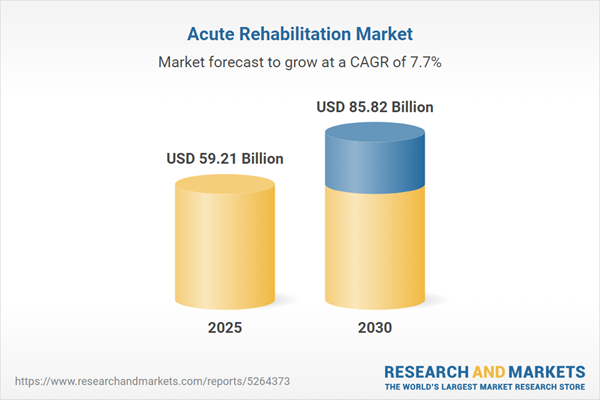Speak directly to the analyst to clarify any post sales queries you may have.
The acute rehabilitation market is navigating a period of significant transformation, driven by technology innovation, demographic shifts, and the growing emphasis on integrated, patient-centered care pathways. For senior decision-makers, staying ahead in this evolving sector requires a comprehensive understanding of trends, challenges, and actionable strategies.
Market Snapshot: Global Acute Rehabilitation Market
The Acute Rehabilitation Market grew from USD 55.10 billion in 2024 to USD 59.21 billion in 2025. It is projected to advance at a CAGR of 7.66%, reaching USD 85.82 billion by 2030. This trajectory reflects sustained demand for multidisciplinary recovery services, advanced technologies, and value-driven care models, making acute rehabilitation a focal sector in modern healthcare.
Scope & Segmentation: Deep-Dive into Acute Rehabilitation Dynamics
- Service Types: Cardiac rehabilitation, neurological rehabilitation, occupational therapy, orthopedic rehabilitation, physical therapy, pulmonary rehabilitation, speech and language therapy
- Cardiac Rehabilitation Includes: Post cardiac surgery therapy, post heart attack rehabilitation
- Neurological Rehabilitation Includes: Stroke and traumatic brain injury rehabilitation
- Physical Therapy Includes: Balance and coordination therapy, mobility and strength training, endurance training
- Disease Types: Abnormal heart rhythms, angina, atrial fibrillation, cholesterol management, coronary artery bypass surgery, coronary or peripheral artery disease, diabetes, heart failure or transplant, high blood pressure, pulmonary hypertension
- Phase Types: Acute, sub-acute, long-term, reintegration
- Device Types: Cognitive and speech devices, mobility devices, monitoring tools, physiotherapy equipment, robotic devices
- Patient Age Groups: Adults, geriatrics, pediatrics
- Provider Types: Home-based rehabilitation, hospitals, inpatient acute rehabilitation centers, outpatient rehabilitation
- End Users: Government and public health agencies, healthcare providers, patients
- Regions Covered: Americas (North America, Latin America), Europe, Middle East & Africa, Asia-Pacific
- Key Countries: United States, Canada, Mexico, Brazil, Argentina, United Kingdom, Germany, France, Russia, China, India, Japan, Australia, South Korea, and more
- Company Coverage: Select Medical Corporation, Encompass Health Corporation, Universal Health Services Inc., Ekso Bionics Holdings, Inc., Cambridge Medical and Rehabilitation Center, Acadia Healthcare Company, Inc., HCA Healthcare, Inc., and others
Primary Keyword Used: Acute Rehabilitation Market
Key Takeaways for Decision Makers
- Integrated care pathways and stakeholder-focused innovation are redefining recovery protocols across inpatient and community settings.
- Technological advances, especially in robotics and telehealth, are enhancing therapy delivery and expanding patient access to rehabilitation services.
- Shift toward value-based reimbursement models emphasizes measurable functional outcomes over procedural volume, incentivizing quality improvements.
- Changing regulatory and payment environments require agility, as tariff fluctuations and cost pressures impact sourcing strategies and investment decisions.
- Regional market differences shape adoption rates of emerging technologies and the structure of service delivery, warranting context-specific operational strategies.
- Industry leaders are leveraging collaborative partnerships to accelerate digital transformation and validate new care modalities in acute rehabilitation.
Tariff Impact: Navigating Cost and Supply Chain Complexity
Recent tariff changes in the United States have influenced procurement and supply chain strategies for rehabilitation equipment, prompting providers and manufacturers to diversify sourcing and explore flexible production models. These adjustments are also fostering the uptake of digital and software-driven therapy solutions, which can maintain high care quality while mitigating financial volatility associated with physical imports.
Methodology & Data Sources
The findings in this report rely on a robust mixed-method framework, combining quantitative analysis of regulatory filings and health databases with qualitative expertise through structured interviews and expert roundtables. This triangulated approach ensures comprehensive, up-to-date perspectives on technology adoption, reimbursement trends, and operational shifts within acute rehabilitation care.
Why This Report Matters
- Enables C-suite leaders, strategists, and policy-makers to benchmark best practices, anticipate market disruptions, and identify partnership opportunities.
- Supplies critical insights into regional landscape variations, helping organizations align service models and investment with local demands and policy frameworks.
- Guides informed resource allocation and technology adoption by translating emerging trends into actionable strategies with clear impact on patient outcomes and operational excellence.
Conclusion
As acute rehabilitation continues to evolve amid technological, economic, and regulatory change, timely intelligence and data-driven strategies will empower sector leaders to advance patient-centric innovation and sustained growth in rehabilitation care.
Additional Product Information:
- Purchase of this report includes 1 year online access with quarterly updates.
- This report can be updated on request. Please contact our Customer Experience team using the Ask a Question widget on our website.
Table of Contents
3. Executive Summary
4. Market Overview
7. Cumulative Impact of Artificial Intelligence 2025
Companies Mentioned
The companies profiled in this Acute Rehabilitation market report include:- Acadia Healthcare Company, Inc.
- Amedisys, Inc.
- Athena Health Care Systems
- Aurora Behavioral Health System
- Cambridge Medical and Rehabilitation Center
- CareOne Management, LLC by New Frontier Energy, Inc.
- Covenant Care
- Ekso Bionics Holdings, Inc.
- Encompass Health Corporation
- HCA Healthcare, Inc.
- LHC Group, Inc. by UnitedHealth Group Incorporated
- LifePoint Health, Inc.
- National Healthcare Corporation
- Nexion Health, Inc.
- Oceans Healthcare
- Promises Behavioral Health, LLC
- St. Ann's Community
- Tenet Healthcare Corporation
- The Alden Network
- The Ensign Group, Inc.
- Universal Health Services Inc.
- Genesis Healthcare, Inc.
- Five Star Senior Living by AlerisLife Inc.
- ClearSky Health
- Paradigm Healthcare
- Select Medical Corporation
Table Information
| Report Attribute | Details |
|---|---|
| No. of Pages | 190 |
| Published | November 2025 |
| Forecast Period | 2025 - 2030 |
| Estimated Market Value ( USD | $ 59.21 Billion |
| Forecasted Market Value ( USD | $ 85.82 Billion |
| Compound Annual Growth Rate | 7.6% |
| Regions Covered | Global |
| No. of Companies Mentioned | 27 |









